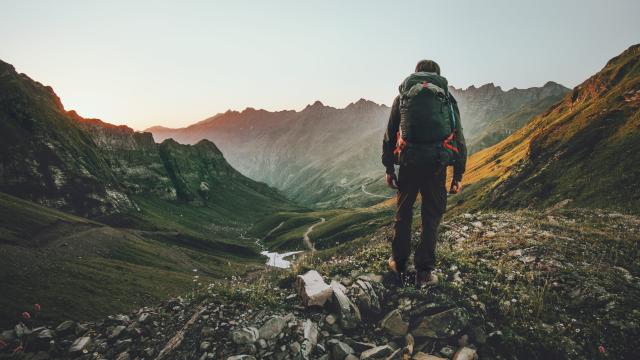An outdoor holiday is one of the safest options for getting away during this eternal pandemic. If you love nature and are particularly ambitious (read: weather-resistant), try planning a backpacking trip.
Backpacking comes with a different set of challenges from your typical holiday because you’ll have to carry all the food and gear you need to keep yourself safe and happy. Here’s what you need to know.
First, the logistics
The first step to a successful backpacking trip is picking your location and planning your itinerary. Ask yourself a few questions to help narrow it down:
- When are you going?
- How much time do you have, and long do you want to be gone?
- Is there a specific trail you want to hike, park you want to visit, or site you want to see?
- How many kilometres do you want to cover? (Related question: are you, or will you be, physically prepared to cover your planned distance?)
- Are you going alone? Who is going with you?
Narrow down your itinerary
After you know when, where (generally), and with whom, it’s time to choose a specific itinerary and scout the route. Search a site like AllTrails to compare trail guides and general trail information. Trail reports and mapping platforms like CalTopo can help you better understand elevation profiles, hazards (snowfields, scrambles, and high river crossings), and possible backcountry campsites.
A few other things to consider:
- Water sources
- Emergency access (road crossings, for example)
- Resupply points
- Exposure (sun and elements)
- Hours of daylight
- Wildlife
- Navigation/route finding
Request permits, if needed
Some parks, wilderness areas, and popular routes require permits for backpackers or overnight camping. Some permits are more of a formality — while you have to apply and pay for them, you won’t have any trouble getting one once you arrive — but others require you to enter a lottery months or even years in advance. Research before you go to avoid disappointment.
Get the gear
Both your comfort and safety while backpacking depend on some basic gear. Obviously you’ll need a pack — you can borrow or buy, but it is likely worth it to have one that fits well and has the right capacity for your trip. REI has a helpful guide to choosing a pack. Other essentials include a stove (with the right fuel), a tent or bivy sack, a sleeping bag and pad, a headlamp, a water filter, utensils, shoes or boots, and lots of layers.
Of course, the specifics of what you need depend on where you’re going and for how long. If you’re backpacking in colder months, you may need more insulated layers as well as gloves and a hat. Ditto rain gear in wet climates. Also consider any ancillary gear required on your specific trail — a bear canister and bear spray, for example.
As long as your shoes and pack fit you well, you don’t need to buy everything new. Ask friends if you can borrow their gear, check second-hand gear shops, or search on Craigslist.
Pro backpacker Andrew Skurka has a customisable gear template to help you select and organise your gear list, and REI has a printable PDF gear checklist. r/backpacking is another resource for everything you might ever want to know.
Make a menu
There are plenty of pretty tasty freeze-dried meal options that require only hot water, so you don’t actually need to cook if you don’t want to. If you’re out for more than a few days, you likely won’t want to carry a lot of extra food weight. In that case, though, you may want to cook a fresh meal or two early in your trip so you’re not eating freeze-dried food three times a day for days on end.
If you do want to do your own meal prep, Fresh Off The Grid has a long list of simple backpacking recipes. And don’t forget snacks: jerky, trail mix, dried fruit, granola, and bars make good backpacking food. Also, M&Ms.
Use this Outside guide to backpacking meal planning to ensure you have enough food to cover your trip.
Plan for your safety
Having as much information about your route as possible can help you prepare for any potential hazards, but it’s also a good idea to take a few extra precautions. First, have multiple ways to navigate: paper maps and a compass as well as offline maps on your phone (assuming you can solar charge on the go). Gaia is one of the best apps for offline mapping.
Next, consider a satellite device like a Garmin InReach or SPOT tracker — something that will allow you to communicate in an emergency.
Check the weather in the days leading up to your trip so you have time to purchase any last-minute gear. Also, brush up on Leave No Trace (LNT) principles so you leave nature the same way you found it. Finally, share your detailed plans with friends and family and let them know when you plan to be off the trail.
Of course, if backpacking isn’t your thing, you can go car camping instead. Most of the preparation is the same — you’ll still have to pick a date, plan your meals, and pack your gear. But you may consider renting a cabin or yurt in your local park or campground instead of pitching a tent, especially if you’re going in the dead of winter.

Leave a Reply
You must be logged in to post a comment.